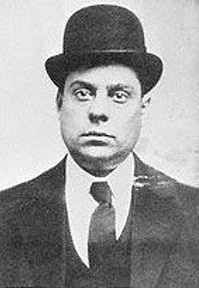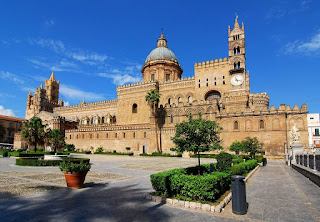Sicilian established first New York crime ‘family’
 |
| Morello was known as 'the claw' because of a deformed right hand |
Morello had a deformed right hand with a single finger that was always bent, on account of which he became known as Joe l’artiglio - Joe ‘the claw’.
Along with three half-brothers, Morello established the 107th Street Mob in the East Harlem district of Manhattan in the late 1890s, a time when it had a substantial Italian population. The gang is recognised as the organisation that would eventually evolve into the Genovese crime family, the oldest of the New York Mafia’s so-called Five Families.
Also known as Piddu, a Sicilian diminutive of Giuseppe, and sometimes Peter among other names, Morello is thought to have been brought up among the criminal underworld in Sicily on account of his widowed mother, Angelina, marrying Bernardo Terranova, a prominent member of the Corleonesi Mafia.
Giuseppe was only six years old at the time but when he reached maturity, he and his half-brothers, Vincenzo, Ciro and Nicolò, began to take part in Mafia activity.
The young Morello is thought to have emigrated to the United States in around 1892 to escape imprisonment in Sicily after a counterfeiting operation he was running had been exposed. He was also suspected of killing a witness to a murder in Corleone.
He settled initially in the south, taking labourer’s work on sugar cane plantations in Louisiana and cotton plantations in Texas, where he was later joined by other members of his family, including his mother and stepfather, his Sicilian wife, Rosa, and their son, Calogero.
 |
| East Harlem in the early 1900s was an area of New York with a large Italian community |
They established links with other criminals, notably another Corleonesi, Ignazio ‘the Wolf’ Lupo, the Mafia boss in Little Italy, Manhattan, who would later marry Morello's half sister, Salvatrice, and Vito Cascio Ferro, a Sicilian with connections to the notorious Black Hand gangsters who terrorised the Little Italy neighbourhood.
As the Morello crime family grew, their rackets extended to loan sharking, fake Italian lottery tickets and robbery and their territory expanded to other parts of Manhattan and The Bronx. They were the first criminal organisation in New York to develop sophisticated money laundering methods through legitimate businesses such as stores and restaurants.
They also introduced the practice of extorting small amounts of money each week from business owners in exchange for "protection" rather than taking large sums that would put them out of business.
The Morello gang maintained their grip by dealing ruthlessly with anyone who crossed them or tried to stand up to them. Lupo, his main enforcer, was said to be responsible for more than 60 murders in a 10-year period, often disposing of victims by forcing their dismembered corpses in large wooden barrels, which would then be dumped the sea, left on street corners or in back alleys, or shipped to other cities with labels carrying addresses that did not exist.
 |
| Ignazio Lupo was Morello's ruthless enforcer |
It was Vito Cascio Ferro who is thought to have murdered the New York police detective Joe Petrosino in Palermo in 1909, in revenge for an investigation that ultimately saw Morello and Lupo jailed.
Morello and Lupo were both released after serving only nine years of their sentences but emerged to find the New York crime scene dominated by conflicts between rival gangs.
Nicolò, the youngest of his three-half brothers, had taken control of Morello activities but in 1916 was killed by the Neapolitan boss in Brooklyn, Pellegrino Morano, as part of the Mafia-Camorra War.
Morello found himself under threat from Salvatore D’Aquila, his former lieutenant, who was now a boss himself and ordered Morello killed.
Morello fled to Sicily, where - thanks to his chief ally, Giuseppe Masseria - he foiled a plot to kill him in Sicily and returned to New York, becoming consigliere to Masseria, with whom he enjoyed some prosperity throughout the Prohibition years of the 1920s.
However, during the so-called Castellammarese War, between 1930 and 1931, in which Masseria and Morello fought against a rival group based in Brooklyn, led by Salvatore Maranzano and Joseph Bonanno, Morello was killed on August 15, 1930, while collecting cash receipts in his East Harlem office, his murderer almost certainly acting on the orders of Maranzano.
Masseria himself was killed the following year, shot dead in a restaurant in Brooklyn, the victim of a plot by some ambitious mobsters he had recruited himself but who now turned against him, including Charles ‘Lucky’ Luciano, Joe Adonis, Vito Genovese and Albert Anastasia, all of whom would go on to become powerful Mafia figures in their own right. Luciano took control of Morello-Masseria operations and the organisation was known as the Luciano family from 1931 until 1957, when power shifted to Genovese.
.jpg) |
| The church of San Domenico in one of the most historic Corleone streets, Via XXIV Maggio |
Corleone, a town of around 12,000 inhabitants in the province of Palermo, was once dominated by Arabs before falling into the hands of the Normans. Its strategic position overlooking the main routes between Palermo and Agrigento meant it was on the frontline in many wars. At one time the town had two castles and was encircled by a defensive wall. Its association with the Mafia began in the 1960s following the outbreak of violence that followed the killing of clan boss Michele Navarra. The link was solidified when author Mario Puzo decided his main character in The Godfather would be known as Vito Corleone after a United States immigration official processing the arrival of Vito Andolini mistook his place of origin for his surname. In fact, several real life Mafia bosses, including Tommy Gagliano, Gaetano Reina, Jack Dragna, Luciano Leggio, Leoluca Bagarella, Salvatore Riina and Bernardo Provenzano, came from Corleone and the Corleonesi clan dominated the Sicilian Mafia in the 1980s and 1990s, when they were seen as the most violent and ruthless group ever to take control.
 |
| Palermo's majestic Cathedral of the Assumption of the Virgin Mary has many architectural elements |
Although Palermo’s reputation has suffered at times because of the Mafia’s presence, visitors to Sicily’s capital these days would normally witness nothing to suggest that the criminal underworld exerts any influence on daily life. Situated on the northern coast of the island, Palermo is a vibrant city with a wealth of beautiful architecture bearing testament to a history of northern European and Arabian influences. The church of San Cataldo on Piazza Bellini is a good example of the fusion of Norman and Arabic architectural styles, having a bell tower typical of those common in northern France but with three spherical red domes on the roof, while the city’s majestic Cathedral of the Assumption of Virgin Mary includes Norman, Moorish, Gothic, Baroque and Neoclassical elements. Palermo’s opera house, the Teatro Massimo, is the largest in Italy and the third biggest in Europe.
Also on this day:
1660: The birth of Baroque composer Alessandro Scarlatti
1894: The birth of architect Michele Busiri Vici
1913: The birth of car designer Pietro Frua
1930: The birth of campaigning politician Marco Pannella









